THE MARGARET & THE MOSS ROSE 1836
One night in March 1836, amid tremendous gales and high seas, two ships were swept onto the Gore. One ship named “The Margaret” was carrying coal. The Captain had his wife and children aboard as well as the crew. As the ship listed the coal in the hold shifted, so making the vessel list even more. The second ship named “Moss Rose” of Bridgwater was also in serious trouble.
Three men, one being Reverend David Davies, took the largest boat available, and attempted to row out to try and save the people on “The Margaret”. Sadly, it was an impossible task, and the family and the crew were lost. Undaunted, and joined by two more men, they set off again and managed to reach the “Moss Rose”, saving all her crew. For this valiant attempt, a commemorative plaque was placed on the sea wall, and a wealthy businessman presented Burnham with its very first lifeboat. The name is unknown, as unfortunately many early records have since been destroyed.
Thanks to June Hill for kind permission to use the extract above from her book “The History of the Burnham Lifeboats”.
THE MILO 1883
In September 1883 the brigantine Milo, out of Rio Grande with a cargo of wet salted hides ran into trouble in Bridgwater Bay. The Burnham lifeboat “Cheltenham” went to its rescue on September 3rd when it grounded on the Gore Sands. The lifeboat “Remained by Vessel”, presumably in case it was called upon to relieve the crew or cargo, which was said to be valued at £10,000 . The report of the Board of Trade enquiry below, from the Western Daily Press, indicates some dispute about who was responsible. The man at the centre of this was a ‘pilot’ co-incidentally named George Reed.
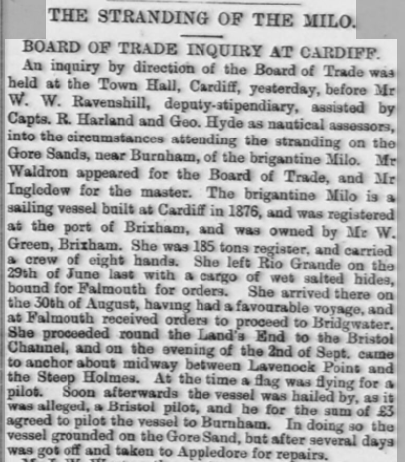
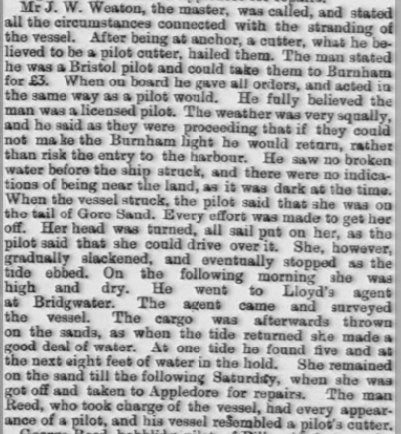
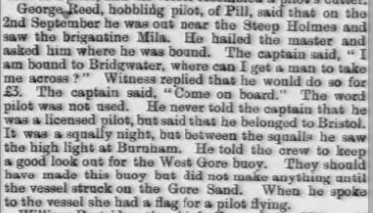
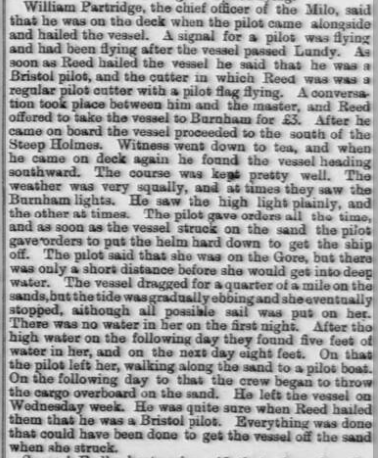
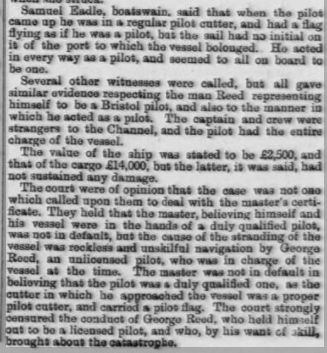
The log of the Cheltenham Lifeboat below has an entry for the Milo rescue.
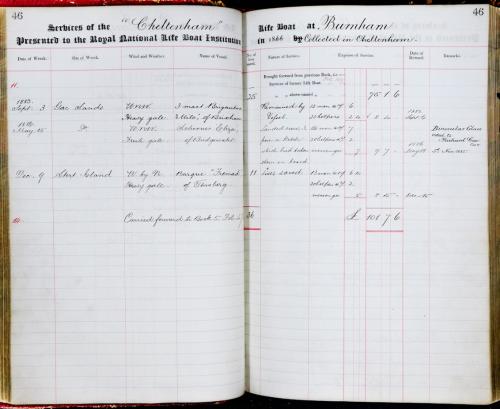
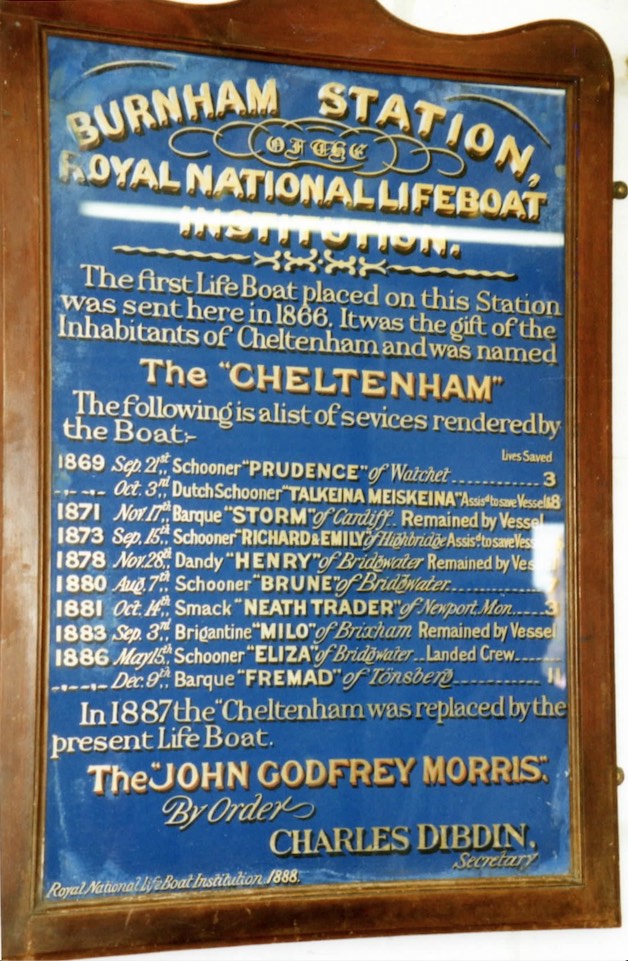
THE NORNEN 1897
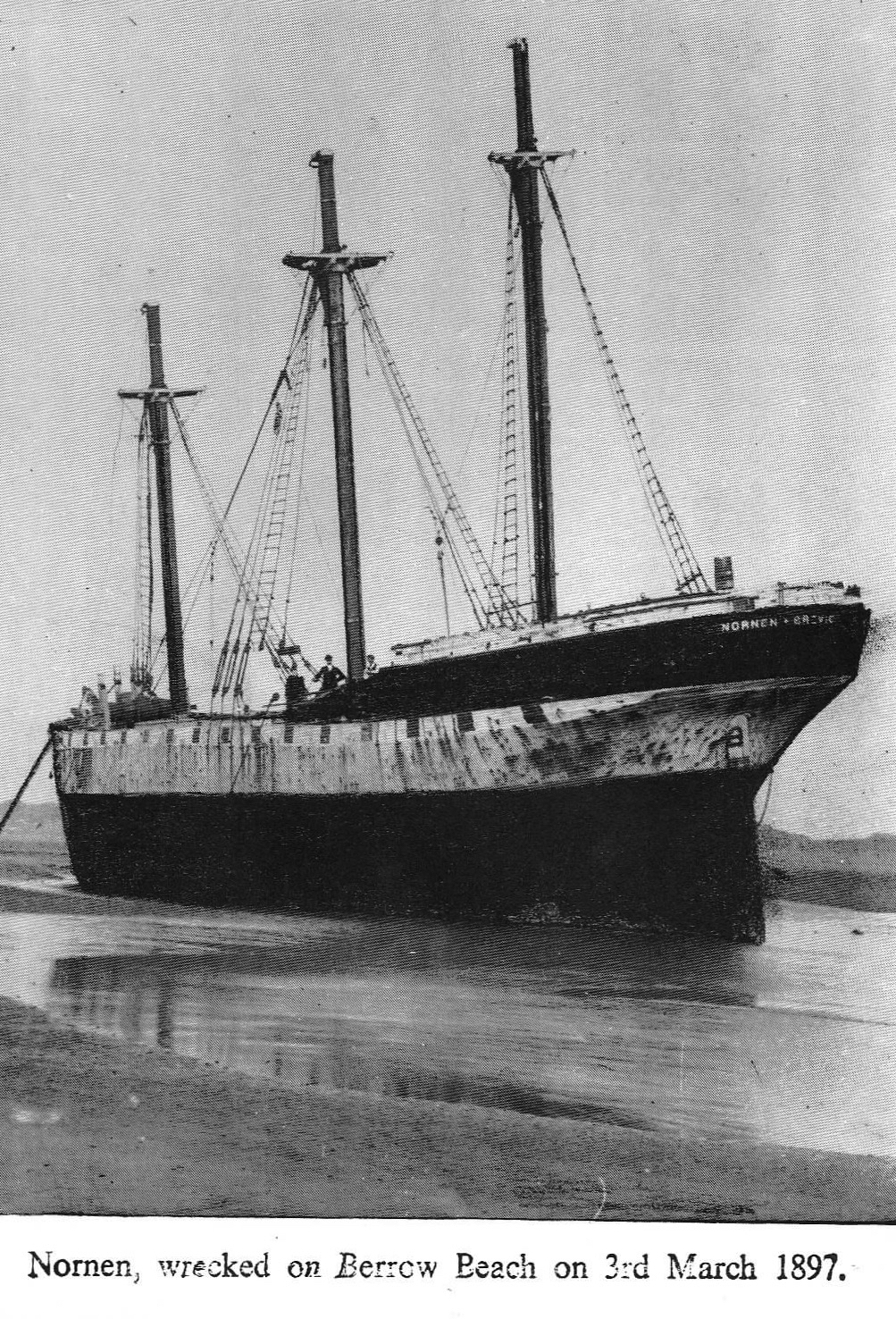 The Norwegian barque Nornen was built in 1876 by shipbuilder Rot T la Roque, Bordeaux for the important French sailing ship owners A.D.Bordes & Fils.
The Norwegian barque Nornen was built in 1876 by shipbuilder Rot T la Roque, Bordeaux for the important French sailing ship owners A.D.Bordes & Fils.
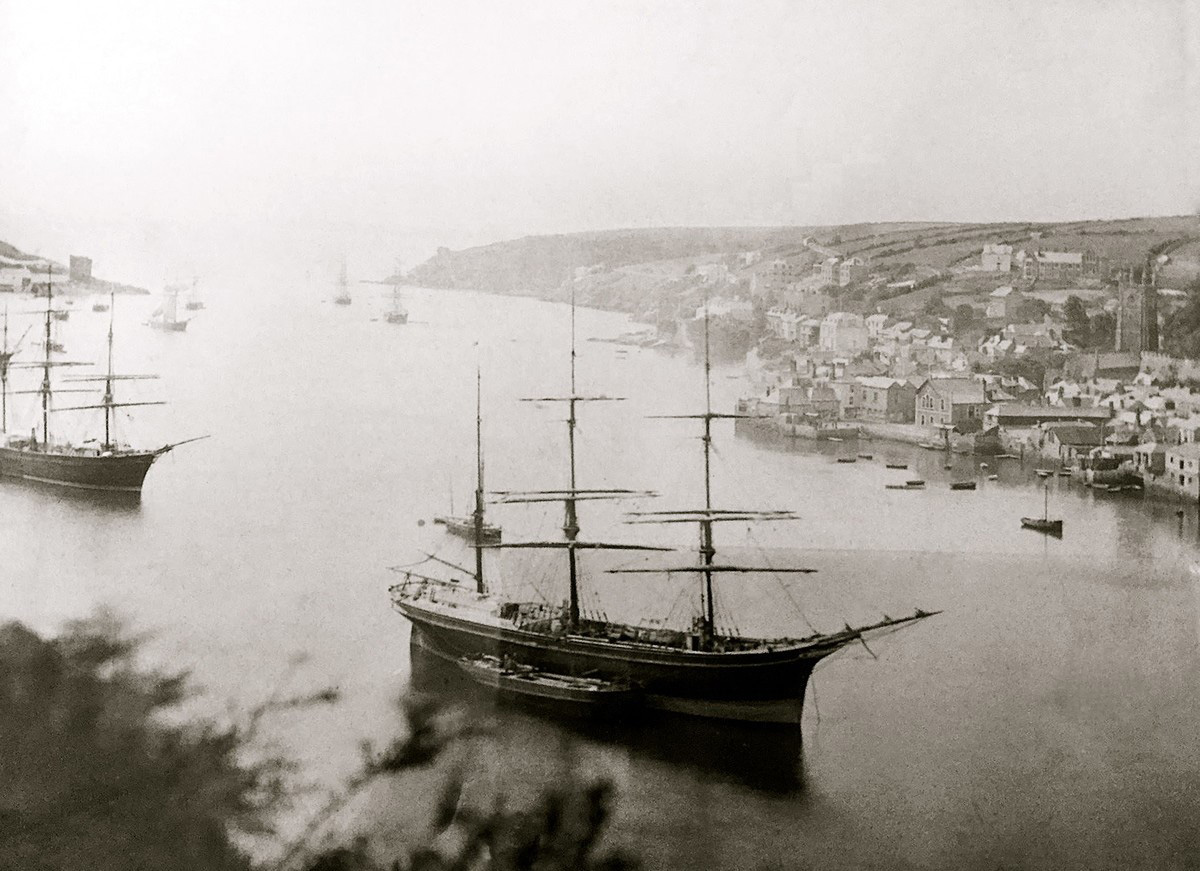
Above: (from an article about ice exports on http://www.brevikhistorielag.no) ‘The Bark “Nornen” from Brevik, belonging to shipowner Samuel Christian Larsen, here anchored in French port. With Severin Paus as skipper, “Nornen” made a trip to New York with ice in the 1890s. The ice was loaded at Skjerke ice in Bamble. The journey across the Atlantic took 22 days. The risk of such a long voyage was too great, so [there was only] one trip. Photo: Brevik historielag’.
It appears, however, that this attribution of the location of the photo is incorrect. Allan Foster has pointed out (see comments below) that the picture was actually taken at Fowey in Cornwall. Perusal of photos of Fowey online confirms this and places date as 1895.
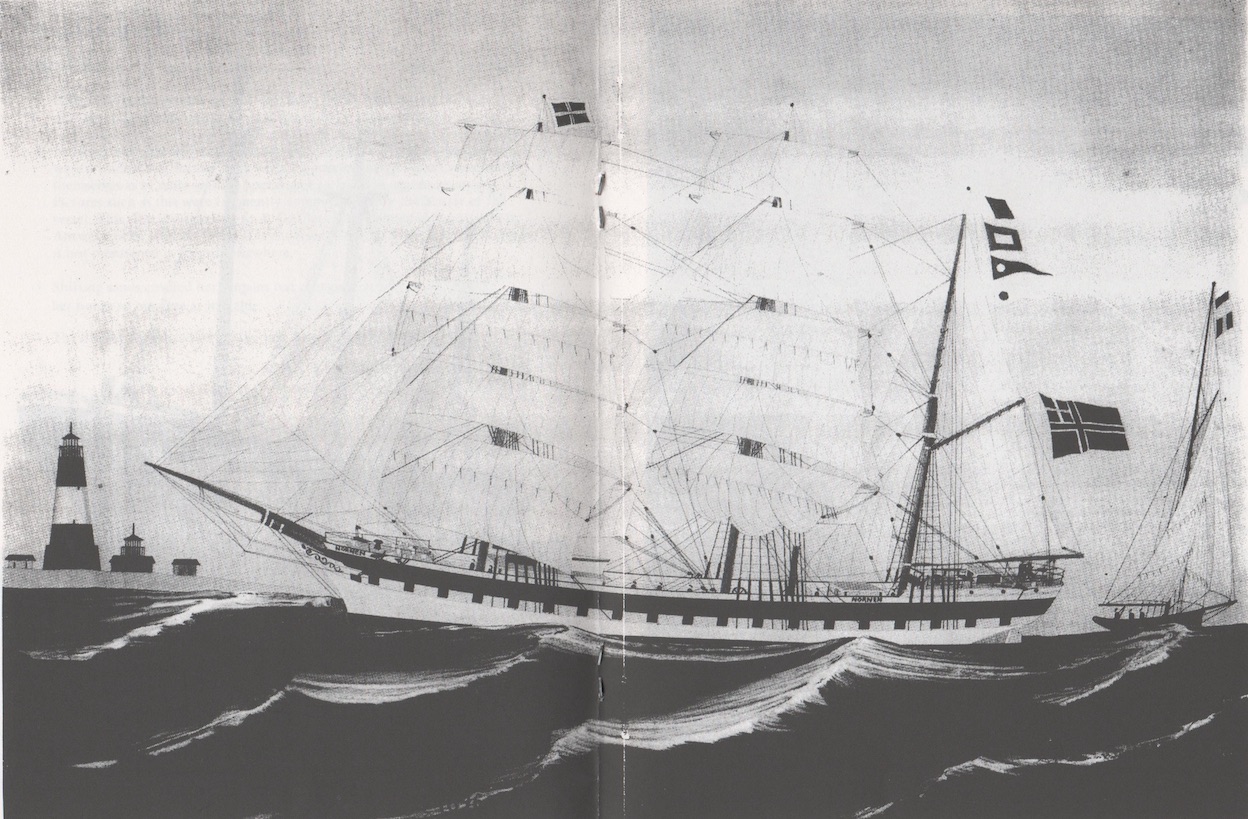
During early March 1897 the seas around the British Isles were subject to heavy gales. Bridgwater Bay did not escape. The steamer Bulldog of Bridgwater and the schooner Richard Cobdon drove ashore at Dunball Sands on the night of Tuesday March 2nd. The outward bound steamers Collier, Devonia and Ethel put back into the River Parret for shelter. Further up the coast the driving snow and sleet was reported at Portishead as being of hurricane force. The Raf from Norway succeeded in obtaining a pilot for Bridgwater but came ashore at Burnham in a damaged state. The ketches Magnet and Good Templar were stranded also but without damage.
All these vessels were subsequently refloated but the wooden Barque Nornen was not so lucky. She was listed in the Port of Bristol Bills of Entry on 7th January 1897 as bringing resin and turpentine from Brunswick, Georgia, U.S.A. On 1st February she was cleared out for foreign parts and sailed for Brunswick on the 8th February under Captain Peder Olsen. What happened between then and the 2nd March is a mystery but it is possible that the Nornen had tried out to ride out a storm in the lee of the Lundy Roads but lost all her sails and was driven towards Berrow mud flats. About 9 am Wednesday March 3rd, when the mist had cleared, she was observed in the bay apparently ashore at the tail of the gore sands,
The John Godfrey Morris lifeboat with 10 oar and 13 crew, was launched under coxswain Mr Alfred Hunt. A rather tedious and circuitous route had to be followed and before the lifeboat could approach the stranded vessel she had been grounded in shallow water. Her captain went over the side and waded ashore but the crew of 10 and their dog could not be persuaded to follow suit so it was up to the lifeboat to land them in very difficult conditions owing to the gale and proximity to the shore.
The rescue is recorded on the honours board of rescues made by the three lifeboats at Burnham during the period from 1867 to 1930 and which today stands in the entrance to the Burnham RNLI Station.
It is a tradition with at least two local families that comforts were provided for the ship-wrecked crew. The late Mrs. Lily Paler of Mount Pleasant, Berrow took tea with her father across the dunes to the men. Likewise the Anderson family took crew members into their home, to dry out. As a reward they were given the figurehead which for a long time stood at ‘Figurehead Cottage’ on the Berrow Rd and is now on display in Berrow village Hall.
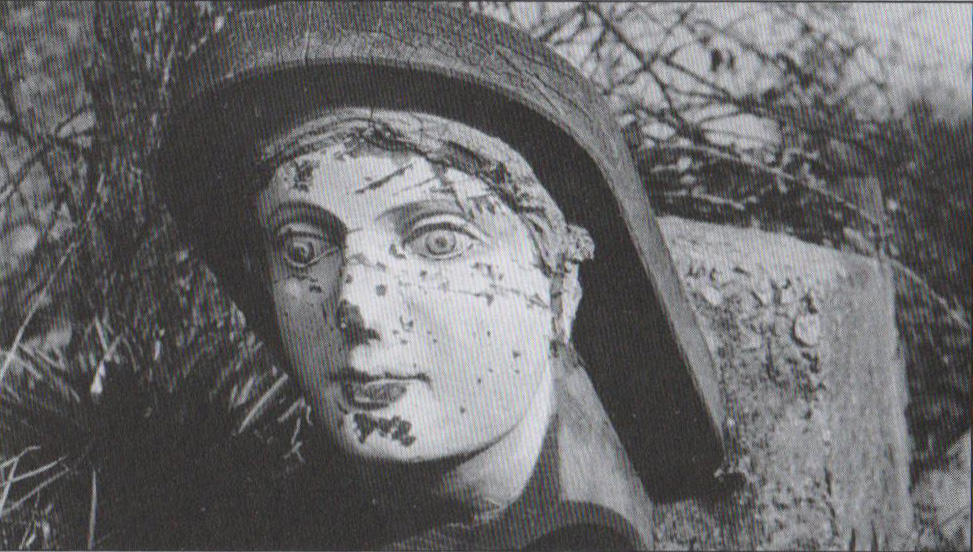
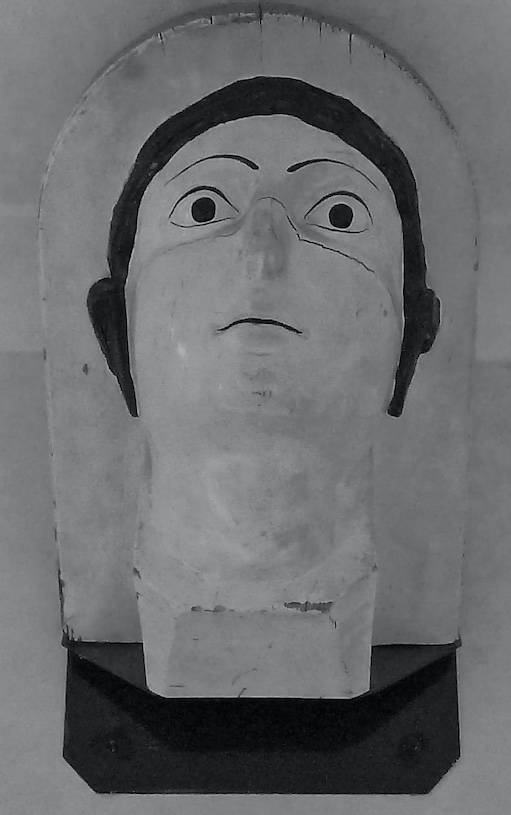
The Captain and his dog, a great dane, were taken into Rose Tree Farm in Barton Rd. Peter Tidball recalls his aunt describing how the dog would stand guard at the door.
John Tidball, who drove his horse and cart to the stranded vessel to help the crew retrieve their belongings, with his family taken outside their Farm house in the same year as the Nornen came ashore. John is leaning on the gate and the little girl is Victoria Beatrice Tidball who lived to be in her 90’s was the person who told the story of the Captain staying at the farm house, and remembered his Great Dane dog guarding the front door. Ann Tidball, the old lady in the photo died on Boxing Day 1897, which helps with the dating of the photo. (Information provided by Peter Tidball.)
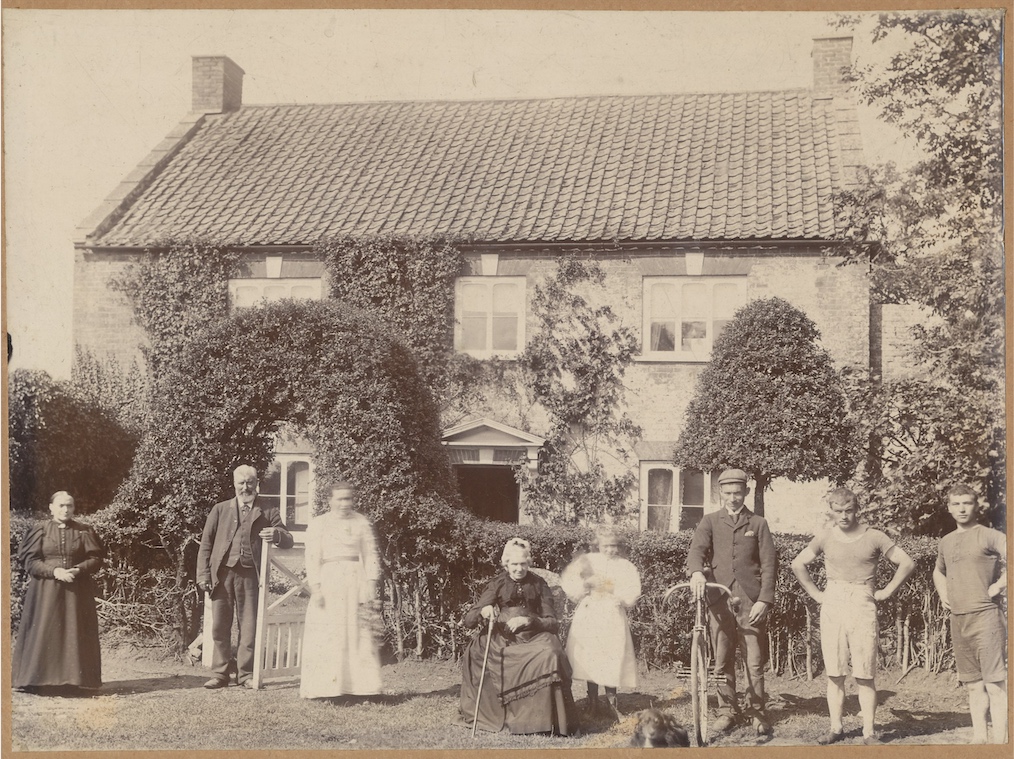
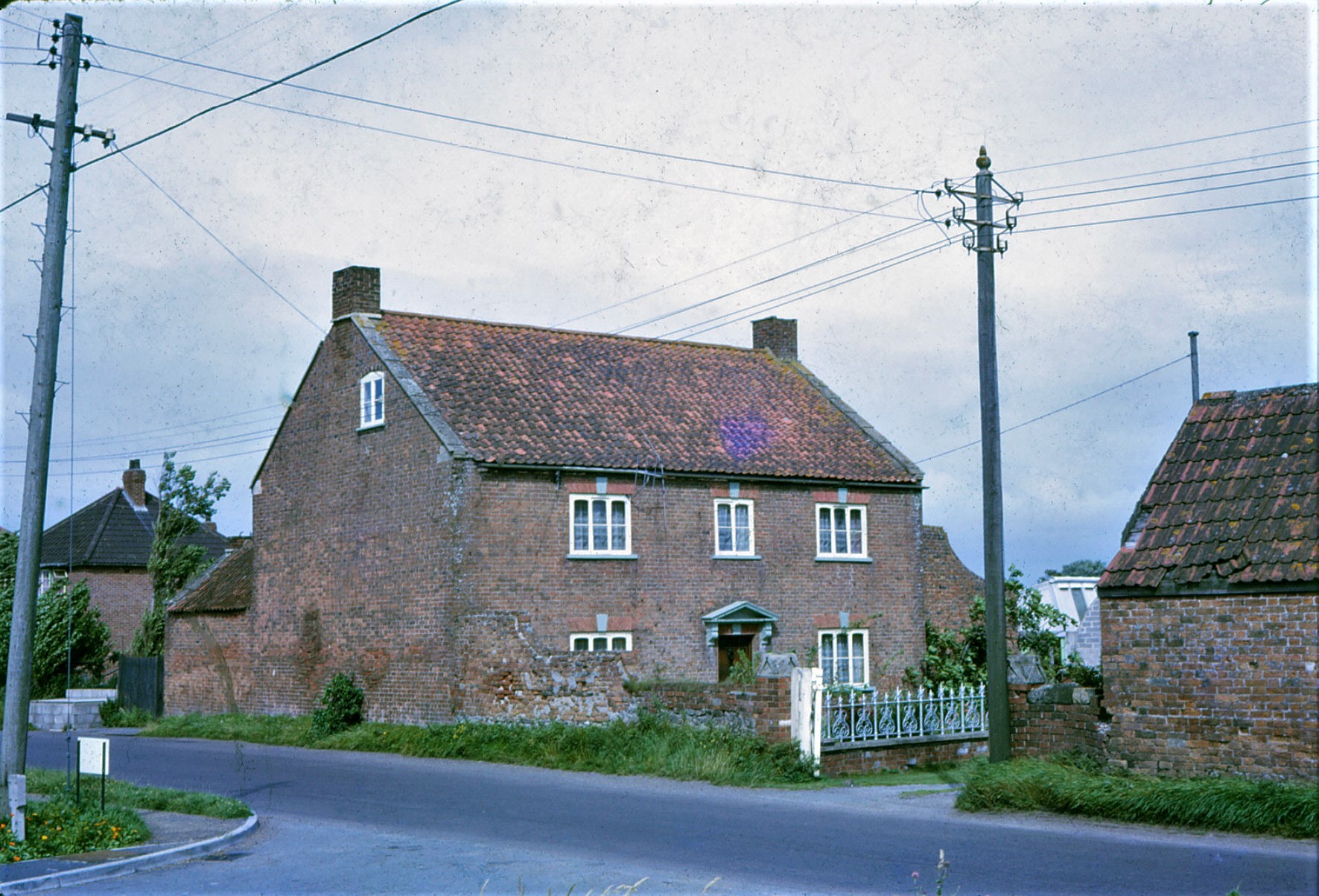
Attempts were made to lighten the Nornen and refloat her but without success and she was driven higher up the sands by a second gale. She was sold as a wreck on 2nd April 1897. The remains can still be seen today.
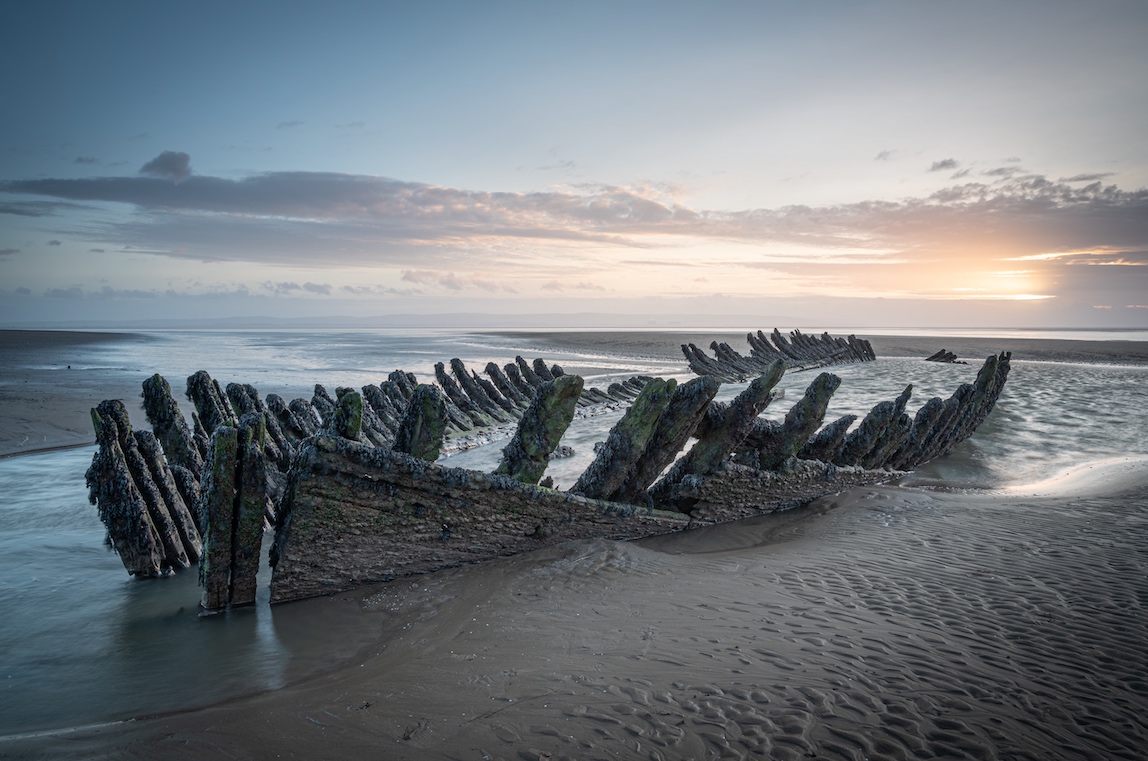
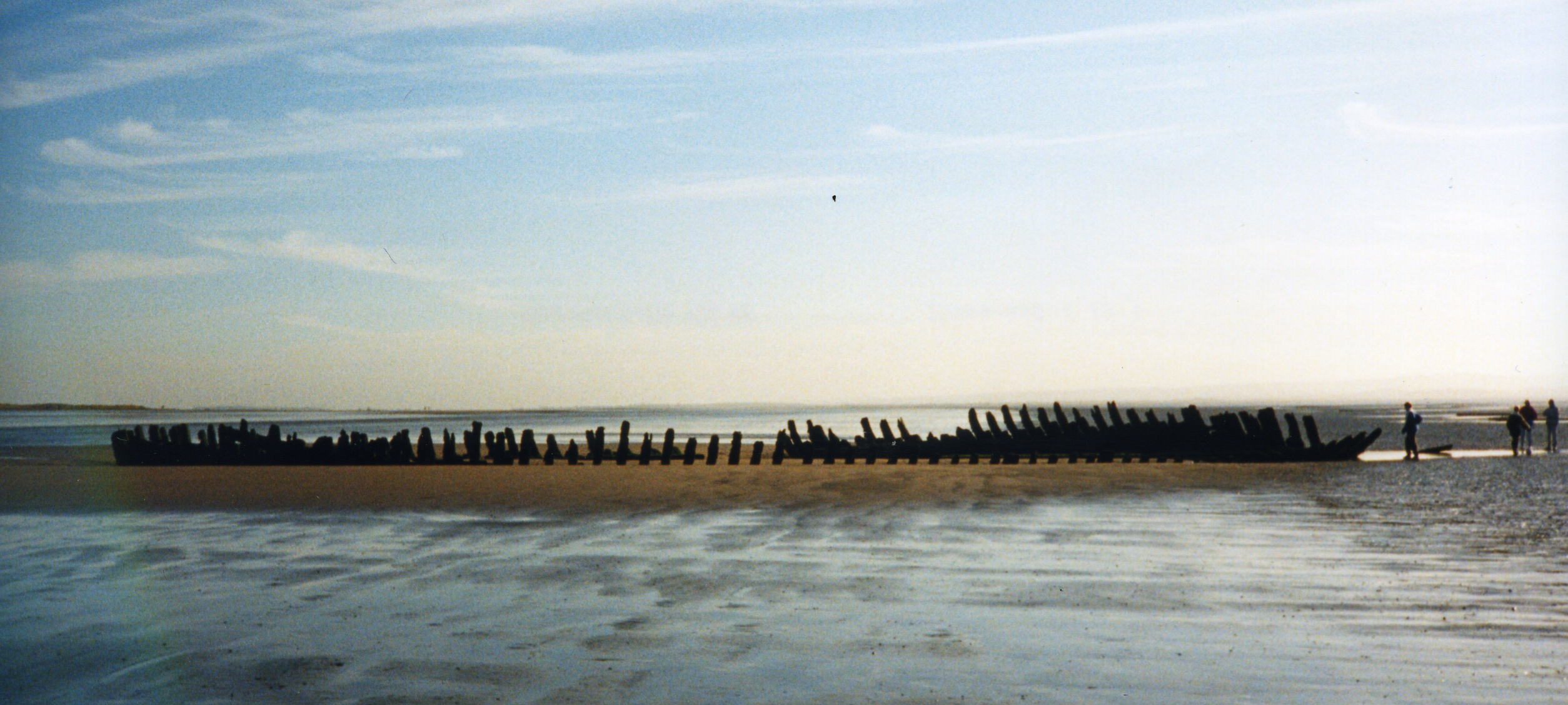
An anchor was found in October 2009, in the mud, close by the wreck. The Bristol Industrial Museum concluded it was too small to have been her main anchor but may have been one of two side anchors used to try and keep her stern on to the tide and thus minimise further sea damage.
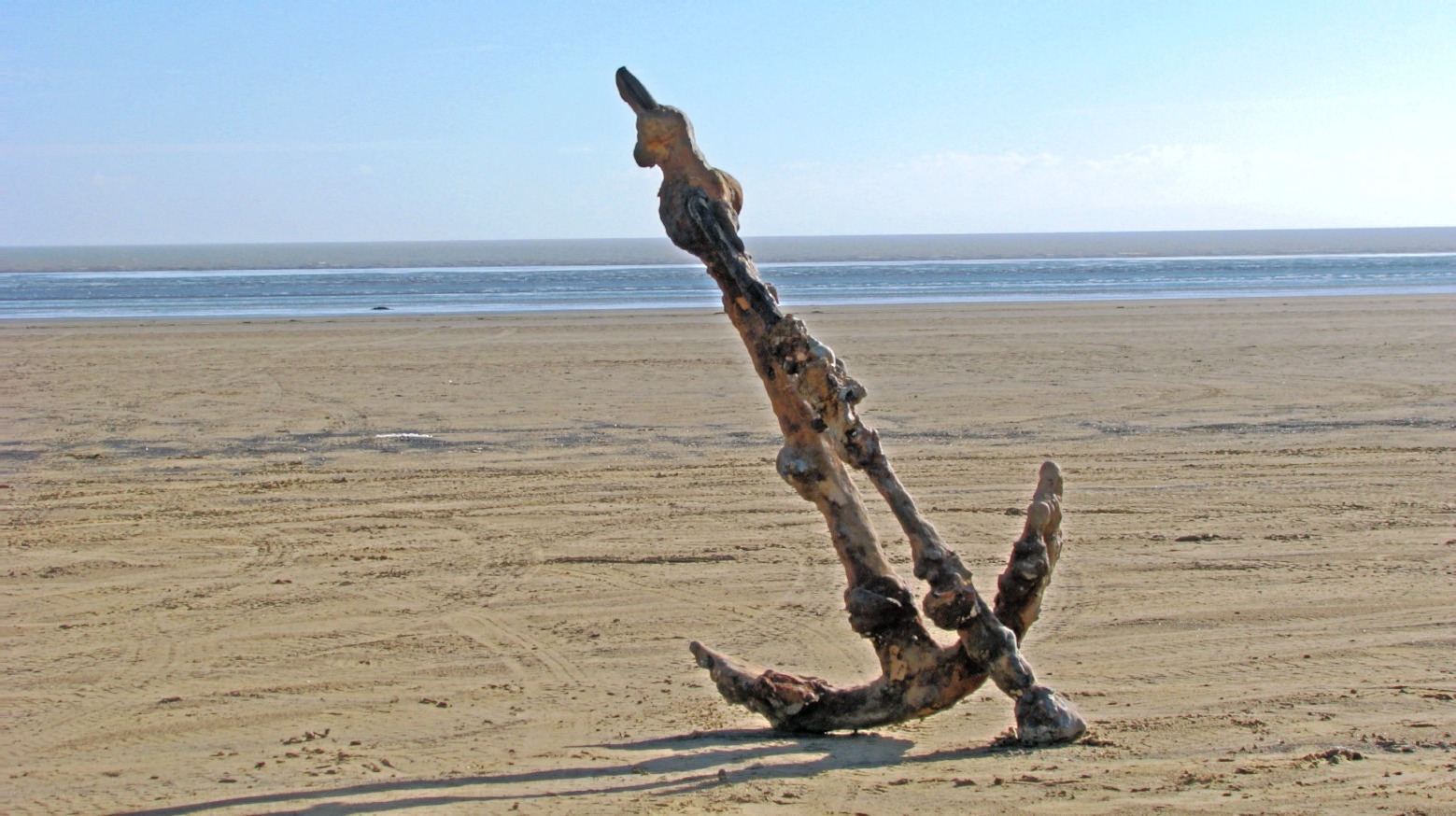
The information about the wreck is taken from the booklet ‘The Berrow Wreck’ by Christopher Jordan and published by Thornbury Press in 1978. Following several requests , asking for more information about this wreck I have tried to contact both the author and publisher to obtain permission to use this material but without success. So please should anyone feel use of this is not entirely for education purposes please contact me via this website. – John Strickland
Below is an oil painting of the Nornen being driven onto the beach. It is painted on a wooden panel labelled on the back as being a panel from the ship itself.
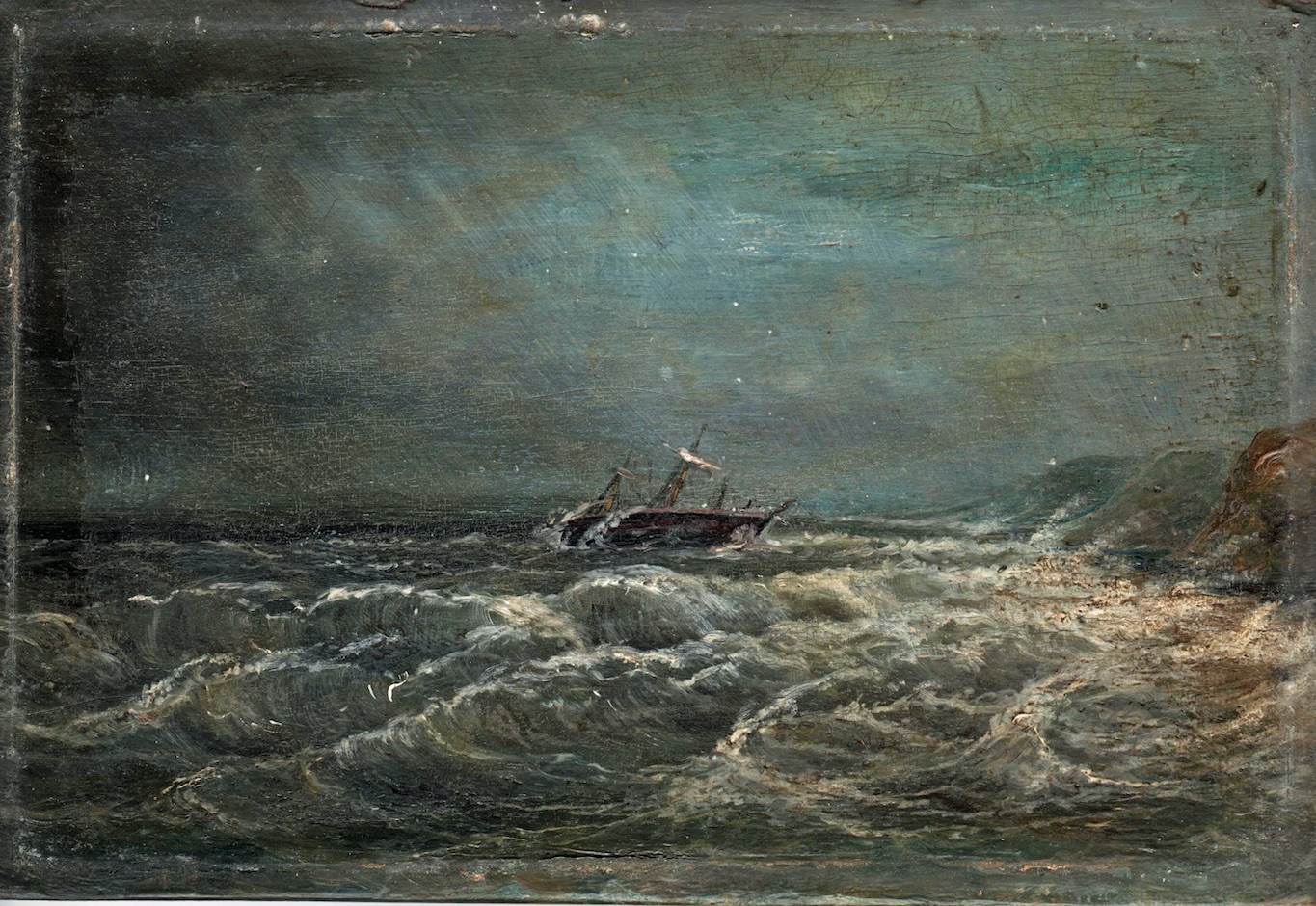
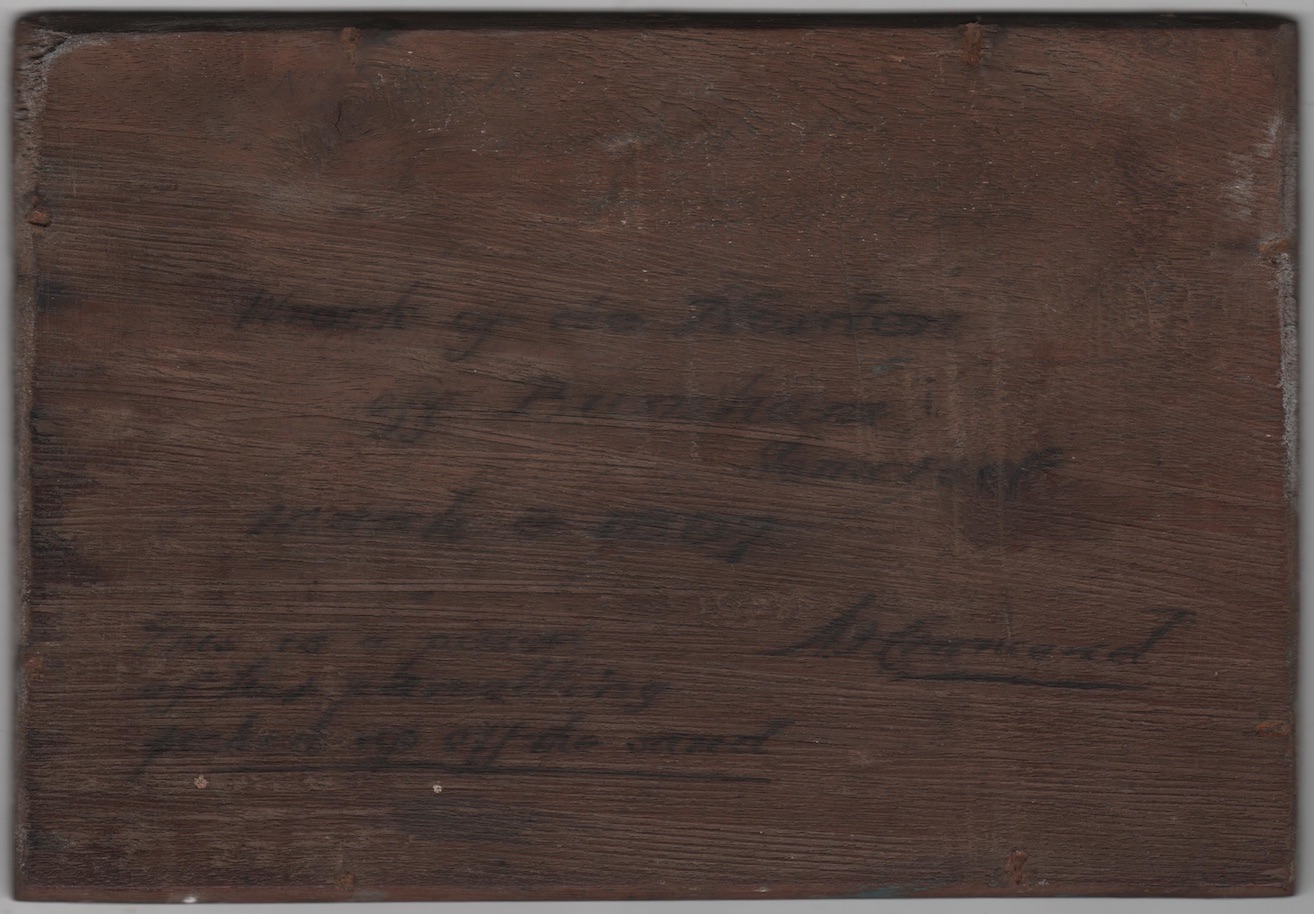
Below: spoon from ship given to a local family. Engraved with the ship’s original name “Maipu” and the ship’s bell.
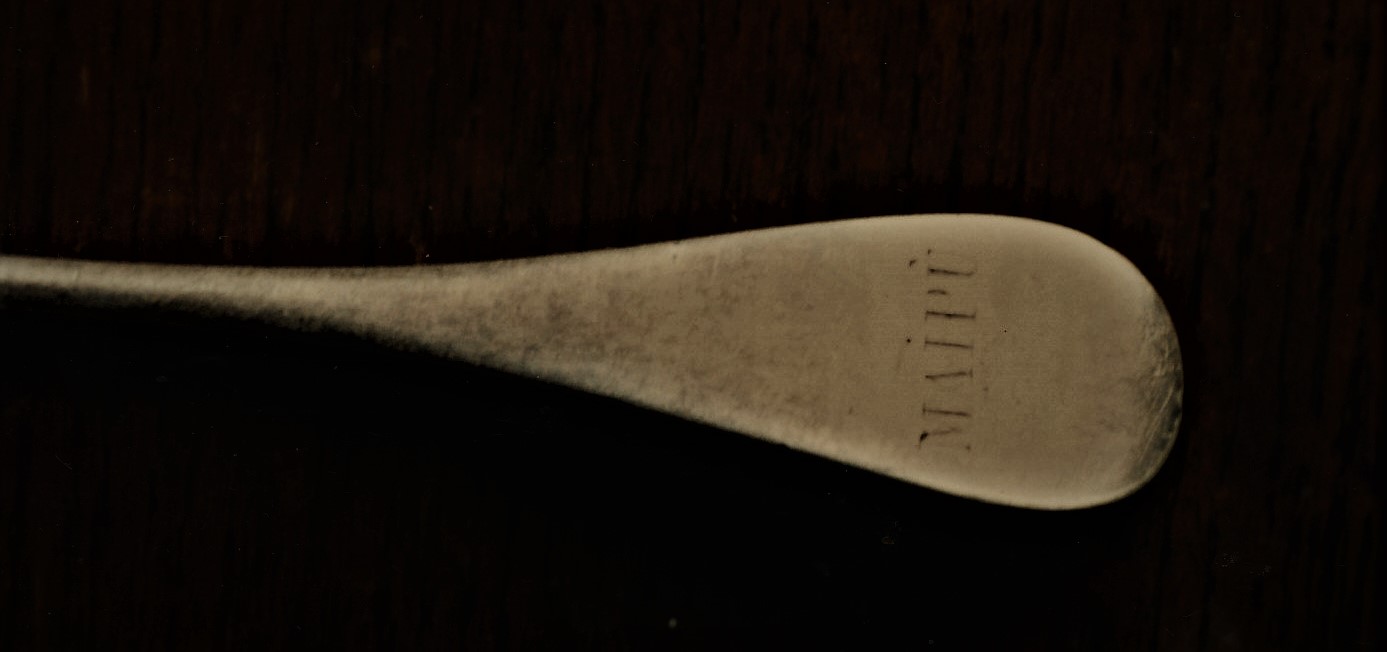
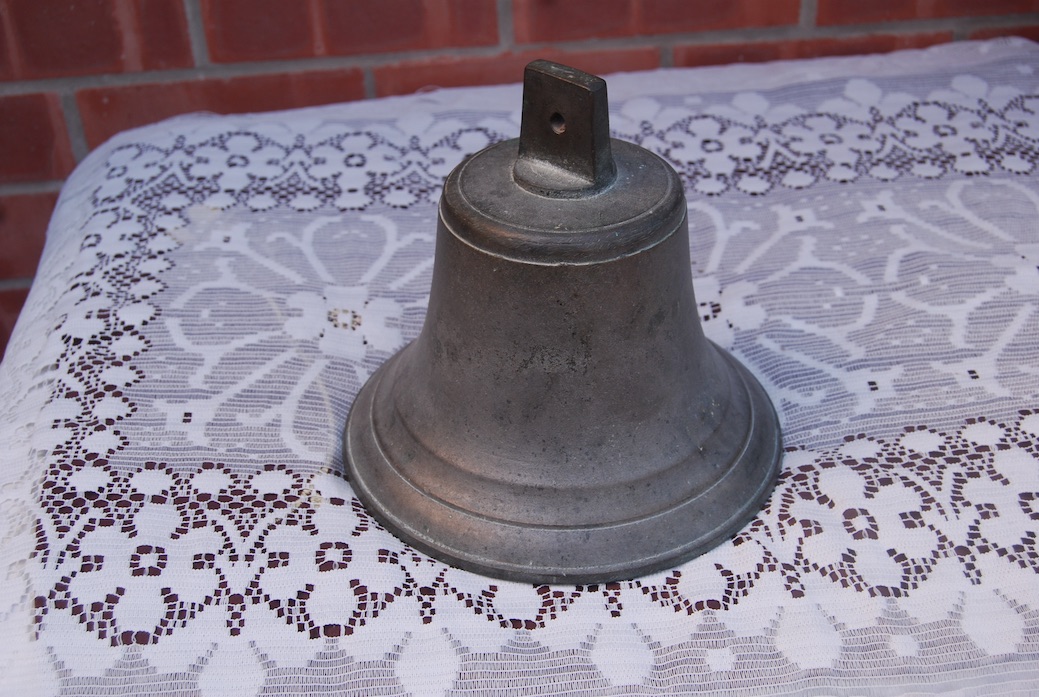
The next image was kindly provided by Nigel Stokes. Nigel was given the Sextant by Mr. Anderson , who lived at Figurehead Cottage, and knew Nigel planned to join the Merchant Navy . Nigel used the sextant many times in his travels at sea. Although we can’t be certain the Anderson family connection suggests the sextant was from the Nornen.
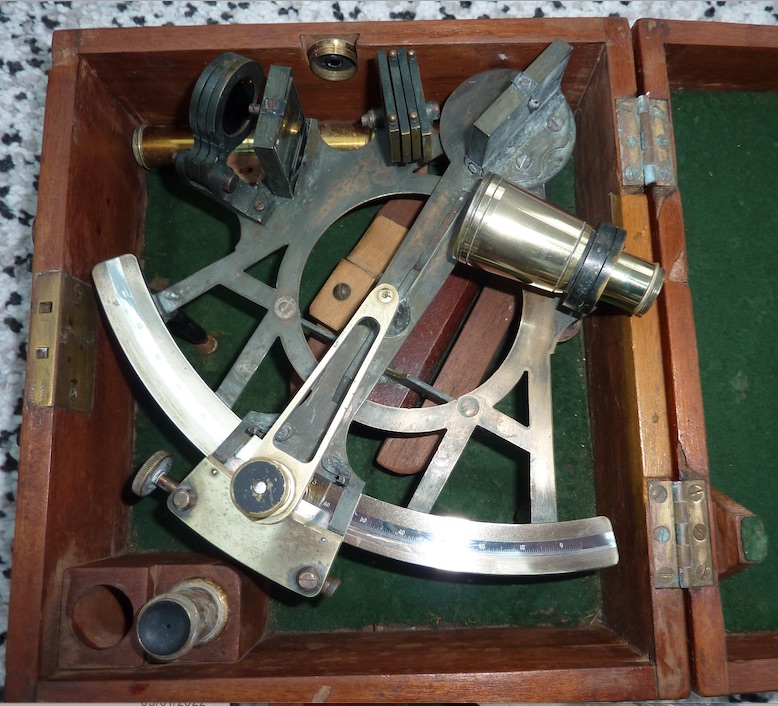
Artist’s impression of the aftermath of the wreck by Bev Vincent:
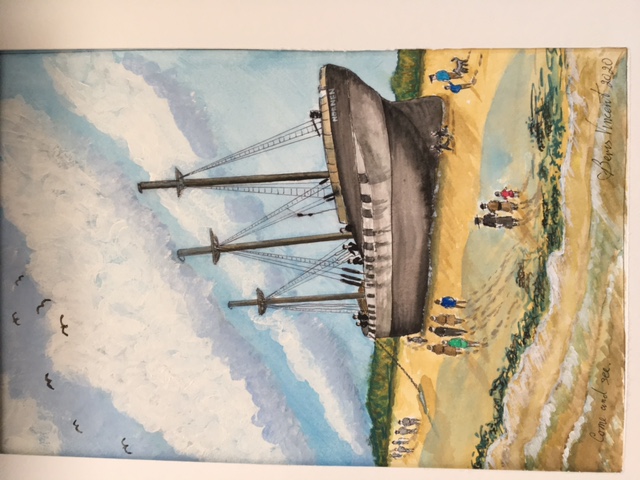
Further information about the Nornen can be found here:
http://www.brevikhistorielag.no/historiske-emner/seilskuter-mannskap/bark-nornen
(Some browsers offer a translation facility when you access this site.)
A performance of a song about the wreck of the Nornen by Barry Walsh can be found here.
Information about the Nornen Project 2022 can be found here:
A new link for 2025-26
BBC Radio Somerset Special – The Nornen: The Story of the Ship in the Sand – BBC Sounds
THE SPEEDY 1903
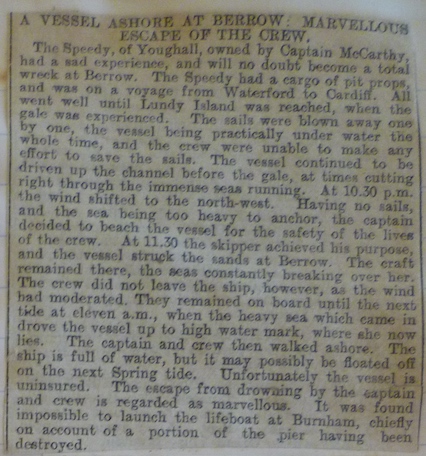
It appears that The Speedy had a similar experience to the Nornen but may have eventually been re-floated as no evidence of the wreck remains now.
See also ‘Major Storms and Floods‘ page
WORLD WAR II
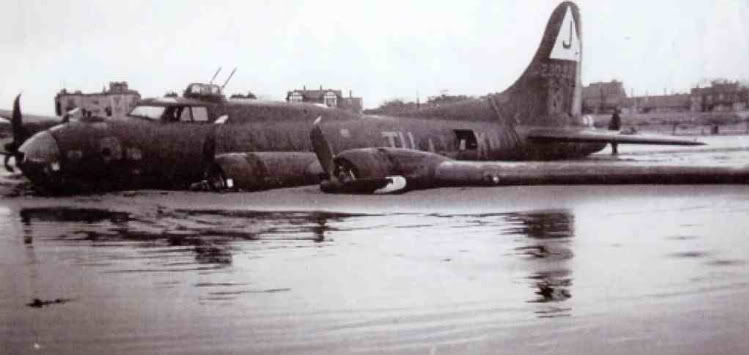
U.S. B17 Flying Fortress ‘ Nobody’s Darling’ of the 351st Bomb Group at Polebrook crash landed on Burnham beach on 31st December 1943 after being damaged during a bombing raid on German held targets in France. With one functioning engine, low on fuel and battered by a storm the aircraft was too low for the crew to bail out.
Captain Robert Chalmers, Pilot Francis Needham and the rest of the crew had to rapidly evacuate the plane as it rapidly began to sink into the mud as the tide came in. The crew were invited into the new Year party at the Queen’s Hotel. There were no fatalities. The were temporarily accommodated in the U.S. military base on the Coronation Field (now the site of St Andrew’s School).
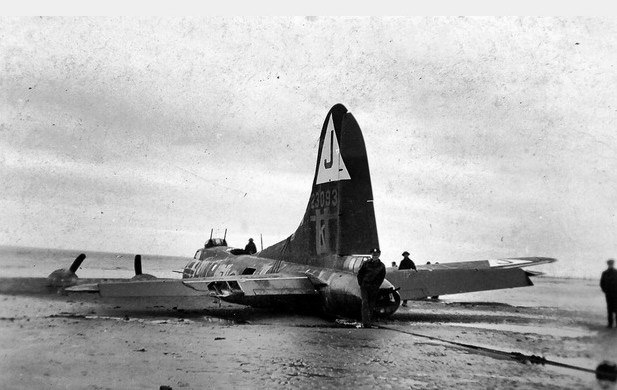
This forgotten story re-emerged in 1990 when tail gunner Walter Skinner wrote to a local newspaper
In 1993 a greetings card signed by numerous local residents was sent to each of the surviving member so f the crew. A plaque was unveiled in 2004 in commemoration of the landing.
For further information see http://www.burnham-on-sea.com/news/2013/walter-skinner-dies-28-11-13.php
It was not the first time that something like this had happened. In 1918 a Handly Page bomber found itself in trouble with engine failure on the way to Milford Haven. Seeing a long stretch of beachat berrow the pilot decided to put down on what he thought to be smooth hard sand. However the wind caused the aircraft to come to a sudden halt, burying its nose in the sand (see Wartime page).
VAMPIRE JET FROM RAF CHIVENOR 1952
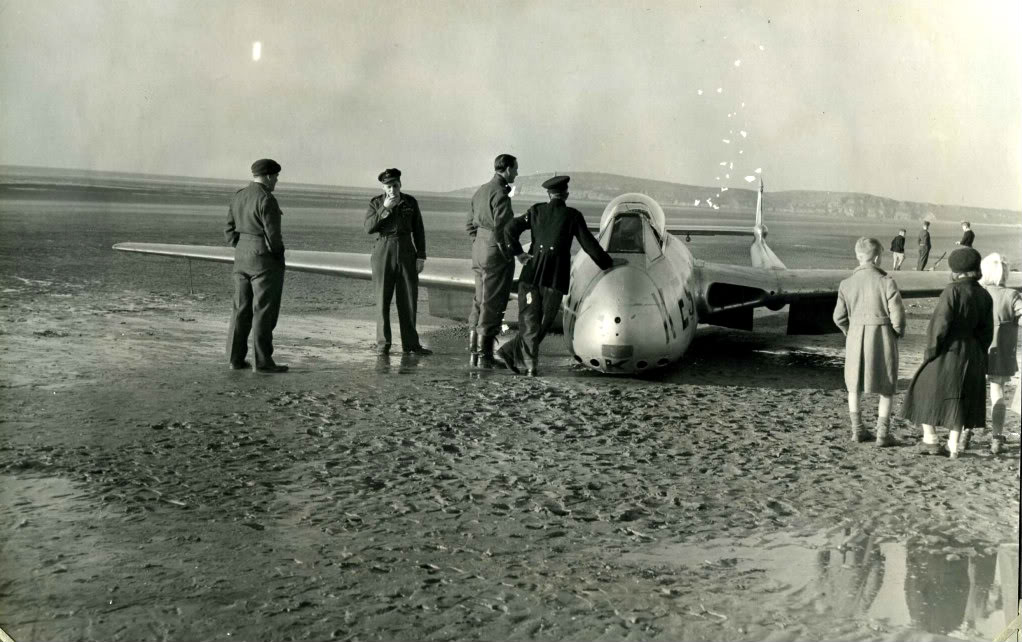
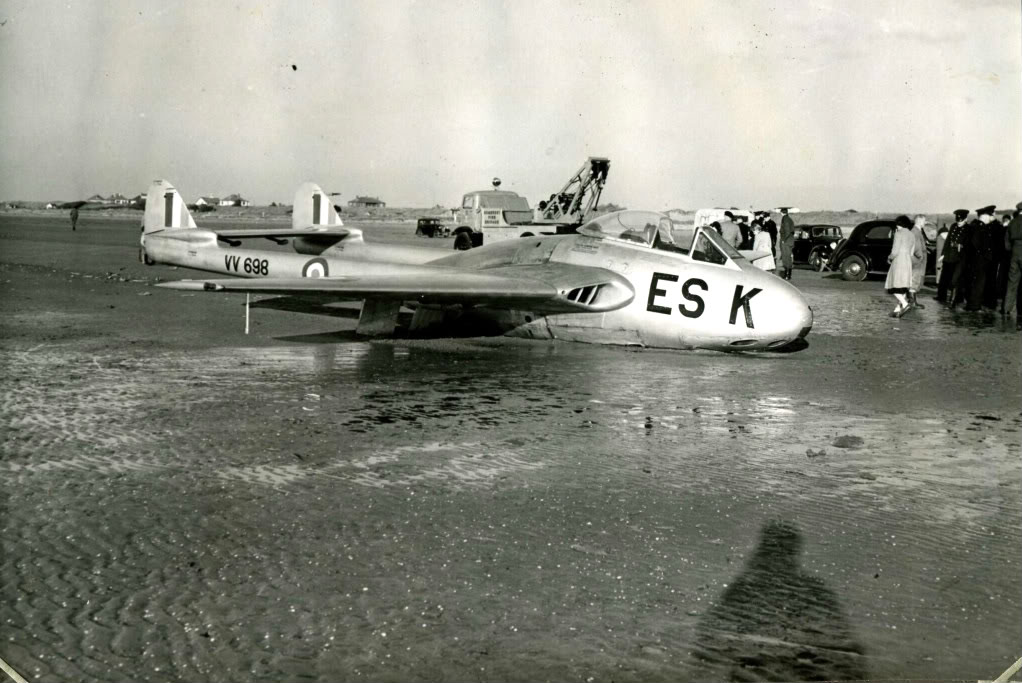
Vampire Jet EEFB5VV698 Engine blew up so forced to land on beach at Burnham 11.10.1952
(http://www.airhistory.org.uk/dh/_DH100%20prodn%20list.txt)
STRANDED SHIPS
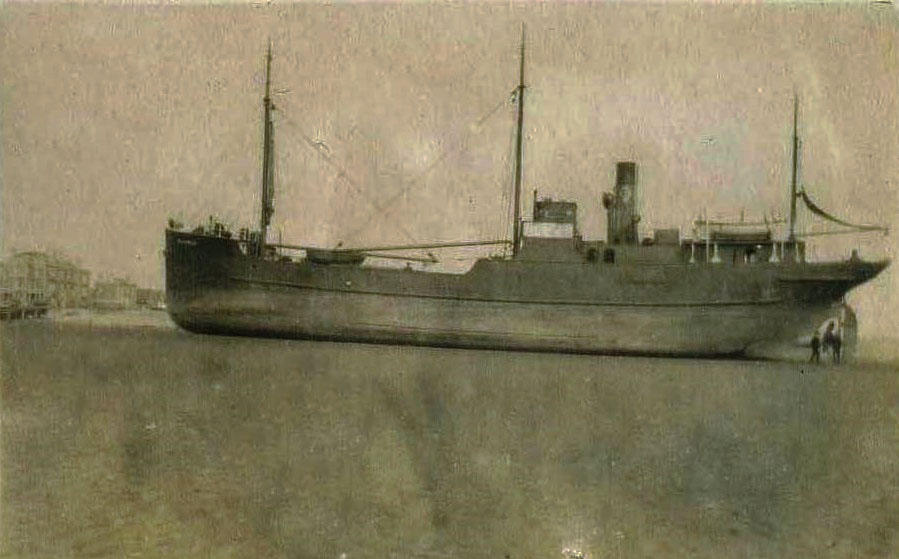
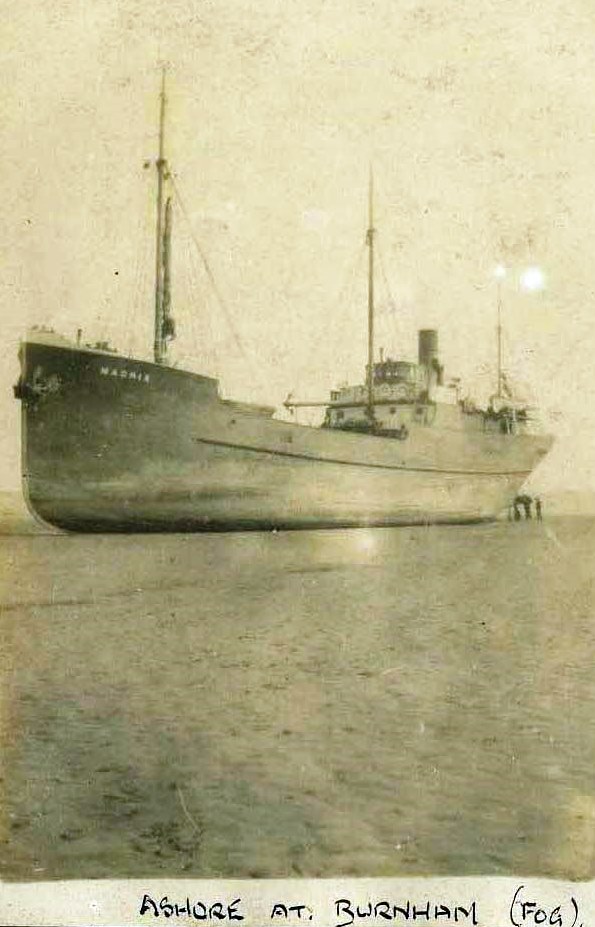
The vessel above appears to have the name ‘Narnia’. Though it seems C.S Lewis invented this name in the 1950’s in his fictional “Chronicles of Narnia” the date of the photos is unknown but they look older. It seems the name may have earlier roots, possibly relating to the Italian town Narni. Any more information about this vessel would be welcome.
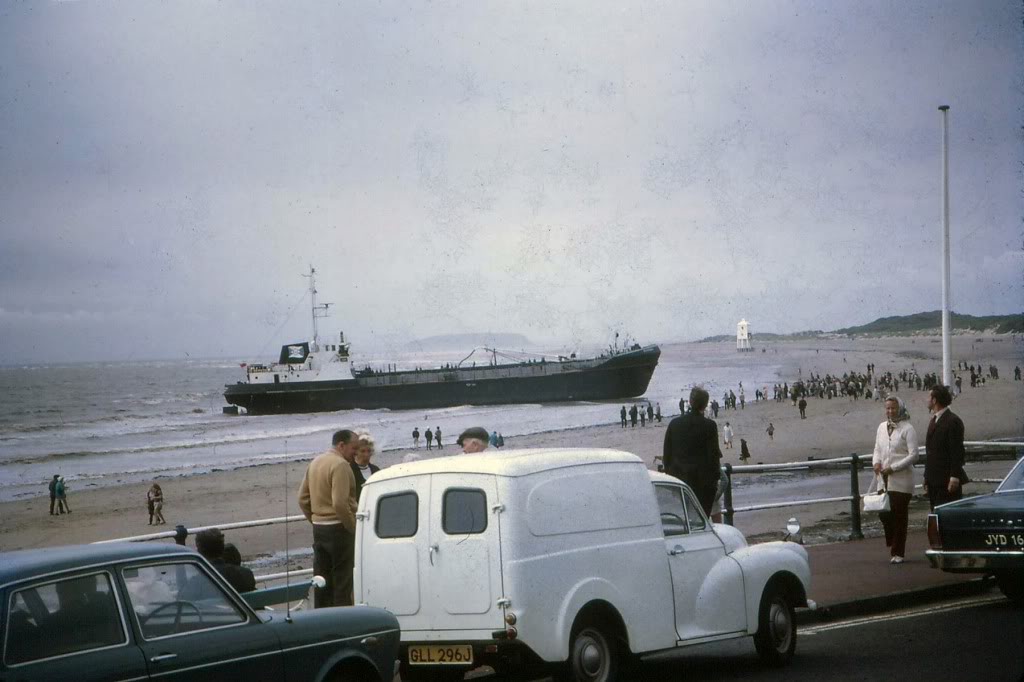
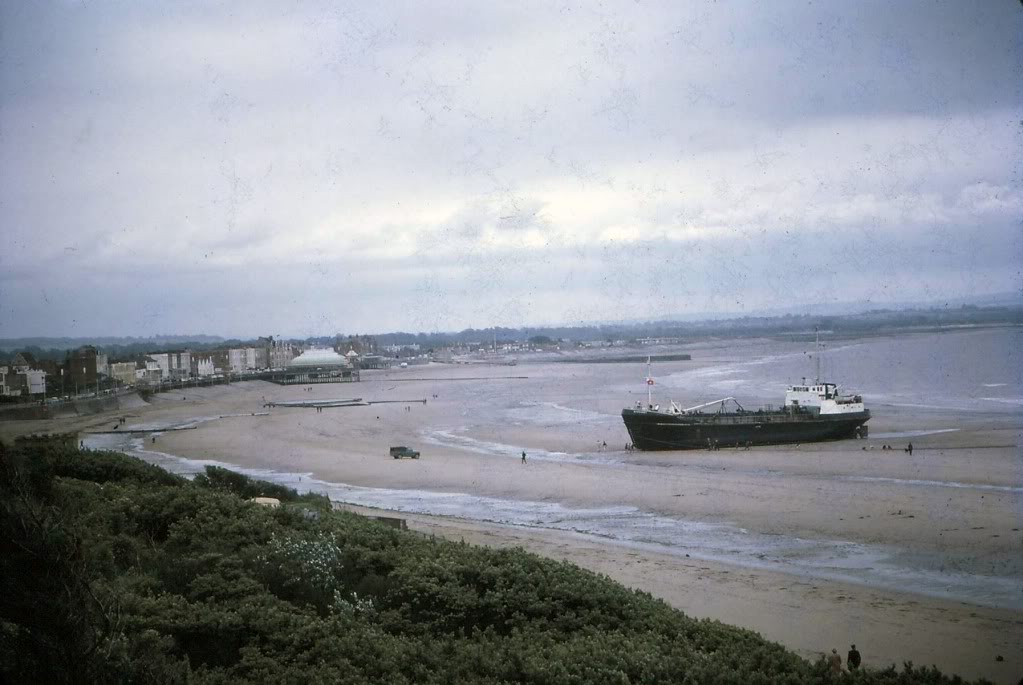
Thanks to Pete Pengelly and Alan Wheway for identifying this event as 1970 or after and providing other details. Thanks also to Iain Howe for the information that the vessel is coastal tanker the m/t Burgundy, owned by Bowker & King London. See comments below for details .
Oil tanker beachings weren’t that rare. Apparently when leaving Dunball empty in a South Westerly gale they were so high in the water their hull acted as a sail and their motive power was insufficient to overcome this so they were blown onto the sands.
———————————————————————————–
A study of shipwrecks in Bridgwater Bay can be found in the journal ‘Archaeology in the Severn Estuary’ 22 (2013), 93-103:
WRECKS OF BRIDGWATER BAY: A REVIEW OF THEIR STATUS, HISTORY AND SIGNIFICANCE
by Justin K. Dix, Fraser Sturt, Michael J. Grant and Sean Steadman
https://www.researchgate.net/publication/269696773
The map below is from that study
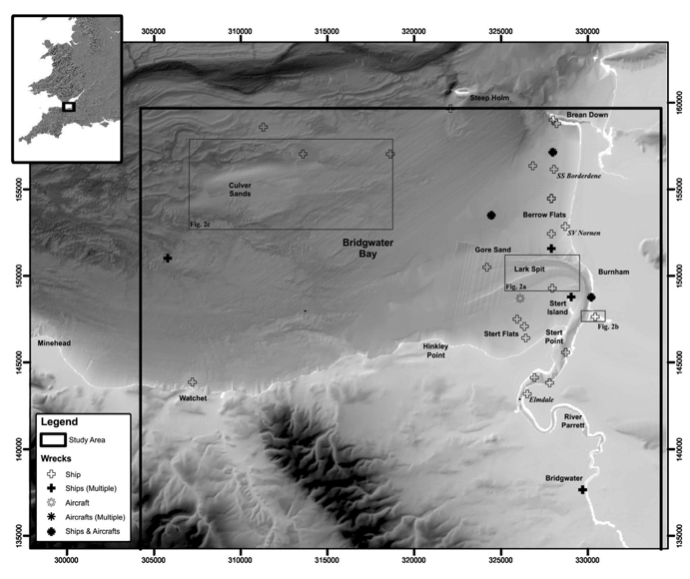
An interesting story of the proceeds of a wreck can be found in ‘Lympsham – A Scrapbook of Victorian Times’ by Peter Hopkins (1989):
In January 1900 there is a reference to the ‘Hicks Charity’, £300 bequeathed to the parish by Edmund Hicks which provided for the poor to receive 3 shillings worth of coal each on New Year’s Day. Hicks, a local farmer, lived close to Brean Down. One day when walking on the sands after a heavy storm he found wreckage, and amongst it a package containing Bank of England notes which he appropriated and bequeathed upon his death.

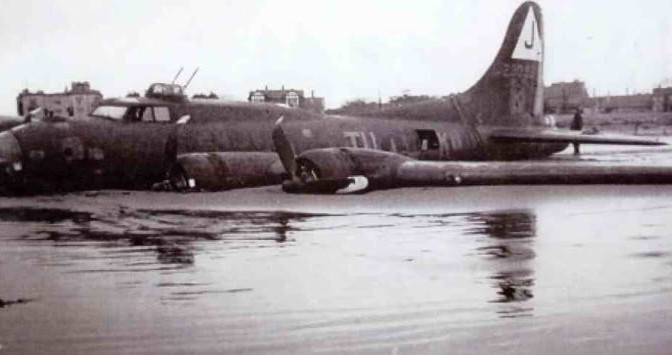
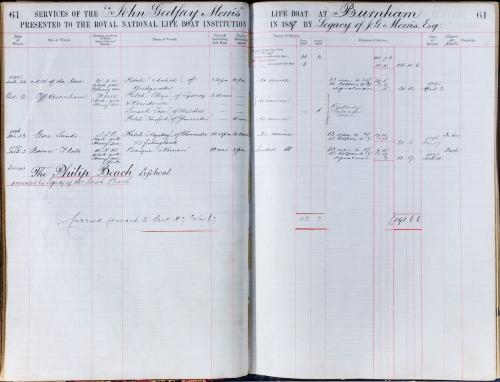
Good interesting information.
A minor correction, ‘Nornen’ photographed in anchored in “French Port” is actually anchored in Fowey, Cornwall
Hello Allan and thank you for this information. Are you certain its Fowey as the image and location was given to us by the Norwegian Historic Society. It would be of interest to know more please as to why you recognize the image as being Fowey. We do know she traded in the Bristol Chanel but have been unable to find the names of her crew or if she traded in other areas of the UK besides Bristol. Of interest I am planning to tell the Nornen’s story at our History Group meeting on 10th May 2023. More details are given on this site under home/News/.
Thank you for your comment as it is only by people posting here we learn more about our history.
Thank you,
John
It would be very helpful possibly for both of us if I could have a conversation with you John. Subject about current ongoing Diamond Garage originally WEMS Garage .
Could or would you please contact me for a chat .
07913237139 Many Thanks
On another aspect . My family origins primarily Gane in Hotwells Bristol c1900 GGM was a Parsons who appear from the verbal records passed to me to have owned a steam powered saw mills somewhere in Highbridge near the Docks they made tomato boxes which were shipped to Jersey and Gurnsey I guess directly on a tramp steamer . I have a paper clipping for the family attendance at the funeral listing who was there if your interested he was some sort of ley preacher and ran the Boys Brigade for many years early 1900’s . This funeral must be about 1930 I could look through my extensive records to be more precise . I think I have the address in Highbridge of the residence . She became Rose Gane ne Parsons married George Gane a carpenter joiner and moved to Hotwells Bristol around 1900 he appears to have been involved with the White City Exhibition Bristol 1911-1914 and was a building supervisor for Frys pithay & Princess Wharf city Docks
Andy Richards .
Hi Allan, I have now amended the text to include your correction. An online search for photos of Fowey confirms it. Thanks for drawing our attention to this error.
It would be very helpful possibly for both of us if I could have a conversation with you John. Subject about current ongoing Diamond Garage originally WEMS Garage .
Could or would you please contact me for a chat .
07913237139 Many Thanks
On another aspect . My family origins primarily Gane in Hotwells Bristol c1900 GGM was a Parsons who appear from the verbal records passed to me to have owned a steam powered saw mills somewhere in Highbridge near the Docks they made tomato boxes which were shipped to Jersey and Gurnsey I guess directly on a tramp steamer . I have a paper clipping for the family attendance at the funeral listing who was there if your interested he was some sort of ley preacher and ran the Boys Brigade for many years early 1900’s . This funeral must be about 1930 I could look through my extensive records to be more precise . I think I have the address in Highbridge of the residence . She became Rose Gane ne Parsons married George Gane a carpenter joiner and moved to Hotwells Bristol around 1900 he appears to have been involved with the White City Exhibition Bristol 1911-1914 and was a building supervisor for Frys pithay & Princess Wharf City Docks where Frys had their export import sheds .
Would Agree its Fowey .
At mooring waiting to go on quay to load China clay for export to be used in quality paper production .
Or to work clay around the british coast for the same purpose .
Hello John
My name is Claudia, a Production Assistant from Blast! Films. We are working on our latest series of Saving Lives at Sea and would love to feature two pieces of archive, I believe belong to you. We are very interested in using The Nornen 1897 from captureburnham.co.uk/events/crashes-and-wrecks and The Nornen image posted by A M Gould Somerset Author on the faceboook page m.facebook.com/dunlinholidayhome/ for our series.
I am contacting you with regards to the rights to broadcast these images. To progress we would require you to send the high-res of this footage, by WeTransfer or any other method you felt comfortable with. Further to this, we would ask you to sign a release form, which declares you as the owner of this footage as well as reiterates any agreements we make in this time.
It is quite urgent, so I hope to hear from you soon.
Hi Claudia,
I hope you have got my messages sent directly to your email.
Looking forward to know when the Burnham feature will be broadcast.
John
Hello John,
Apologies for missing this message. It was featured in the 6th episode. Although, it has already broadcast on tv, you can watch it on BBC iplayer. Thanks again for your help John, I hope you enjoy the episode!
Hello, and hope you are well.
I’m creating an article about local shipwrecks and have dug deep into Norwegian archives for the Nornen. I’ve designed a new 38th scale model of her early days, similar to the RNLI model. Now, the only known photo is of the ship during salvage (as you have above, top) and the painting of 1896 seems to be the only one too. Where would I obtain these pictures? (These days with all the copyright nonsense I’d better check!). If possible, maybe link to this site? Just a thought. I’m writing a full wiki article for the Nornen as she richly deserves it!
Hello Steven,
A link to this site would be best please.
John
Hi, I’ve found original sources and there seems to be confusion as to original ownership of the painting other than it belongs to Brevik (they have an original) and the salvage picture has no copyright reference of who actually owns it! The full article would not look right without pictures so I’ve just updated the UK shipwrecks.
Steven
Hello Steven,
Thanks for your interest and sorry we can’t help more.
John
Hi John,
Apologies for the slow reply but I’ve been having trouble with posting it! Thank you so much, that’s really kind. It turns out that my Grandparents have the same booklet, so I have borrowed it from them. Thank you for adding more information about it to the page. I shall look into those names and follow your suggestion of taking a closer look at the lifeboat page too. It’s all so interesting!
Thank you again.
Corrinne
Hi John,
Just wondering if I might be able to pick your brains about a possible project around the Nornen please? I’d like to tell the story of the wreck and include an educational element around investigating local history. I wasn’t sure how best to get in touch, so please do let me know if there’s a better way!
Corrinne
Hi Corinne, thanks for contacting us again. John Strickland will reply to you by personal email.
Is anyone able to tell me more about the people involved in the rescue of the Nornen? Or indeed those on board? Failing that, any pointers for learning more would be much appreciated. I want to find out as much as I can about the whole story.
Hello Corrinne,
I have a booklet that tells her story and the rescue. There are some people named on it and I will search my records and get back to you with details. It’s such a shame the wreck is now loosing some of her structure. In the 1960’s a scrap merchant used explosives to try and recover some of her metal sheeting but thankfully her structure held. Somerset County Council was concerned she was a safety threat to jet skiers and had plans to spend £25,000 having her removed. I am pleased to say with the help of Berrow Parish Council and a risk assessment I produced she is still there today. The is a display in Berrow Village Hall together with her figure head which is recorded as being given to a local family after they took her crew in and gave them tea.
Thanks for your interest in our local history.
John
Hi John,
That would be fantastic, thank you! Yes, I did read that she’d been saved from removal by the Council, which is wonderful. She’s a fantastic landmark. Ah yes, someone did mention that the figurehead is in Berrow Hall. I’ll have to pay it a visit. Well done for helping to save her!
Thank you again for your reply and your kind offer to find out more details.
All the best,
Corrinne
Hello again Corrinne.
We have updated this page with the information of people involved with the recovery of her crew and the names of the lifeboat crew of the John Godfrey Morris, in 1989, can be read on our lifeboat page – although these may not be the same crew involved with this rescue. I have a copy of this booklet and can post this to you should you wish. In that case please reply to this web but wait for me to contact via your personal email before giving your address etc.
Thanks for your interest.
To join the glorious company of pedants…………………..The’ Nornen’ seems to have no funnel, nor a propellor, so can it be called SS, which stands for Steam Ship?
Hi Clive,
You are probably quite right. I don’t know how the S.S. slipped in there but even I, as a nautical ignoramus, do really know what it stands for. I hadn’t spotted that the photo shows no evidence of it being any such thing! I have now removed the offending initials. Thanks for the heads-up we do like to be as accurate as possible.
Just being a little pedantic here and also wishing to ensure an accurate record. The Vampire accident was not late 1950’s but in fact occurred on 11 October 1952 and involved an FB5 variant flying from RAF Chivenor with 229 Operational Conversion Unit.
I am very interested on this accident and would love to know whether anyone has any other photographs I could see and also maybe the pilots name. In fact any information would be wonderful.
Regards
Brian Lewis
Thanks for the info Brian. What we have is often pieced together from contextual information, in this case info we had about Westonzoyland airfield. So it can be tempting to make inaccurate assumptions. You spurred me to do a specific search so I have now found a record of this machine at http://www.airhistory.org.uk/dh/_DH100%20prodn%20list.txt. I have amended the caption accordingly.
Flying Fortress crash – landing.
My Father was stationed at R.A.F. Locking during that time on a flight mechanics course.
He and others were sent to the crash site with rifles to guard the aircraft from souvenir hunters.
On reading the news report, they did not manage to stop the plundering. No wonder my Father said there was no ammunition in the rifles.
He remembers one of the crew asking him to take photographs which he duly obliged.
His name is Robert Cook now aged 92 living in Stourbridge, West Midlands.
Thanks for the information Helen, it all adds to ‘the story behind the story’
Thanks Pete, and well spotted, that’s a detail I missed.
I have amended the caption accordingly.
– Moderator
The Morris 100 van centred at the bottom of the picture has a J at the end of it’s registration.
That would make it 1970 or later.
I was about 18 when this happened.
The tankers used to unload regularly at the Dunball Shell Mex / BP depot now the site of ADT car auctions.
This one left on the next tide I think. I don’t remember it being very there long.
Nigel
a “J” registration was for 1971. I had owned an Austin 1300 with a”J” plate. Just being very, very pedantic. I also remember a boat running aground by the Clarence and being in the snug bar at that time and overhearing two men from the ship speaking Russian (i learnt Russian at school). It may have been this ship, although it was not an isolated event.
The coastal tanker on the beach is the m/t Burgundy , owned by Bowker & King London. While working for company, I sailed with captain who had beached vessel. First time seeing photo though.
Thanks for the information Iain. Glad we have been able to show you a picture of the event you had not seen before. I have updated the text to include your information.